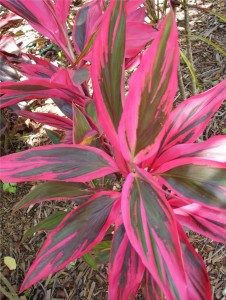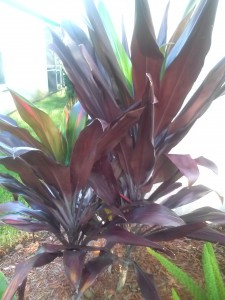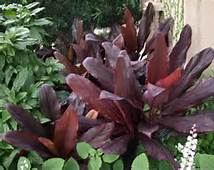Most people are familiar with the Red Sister Ti Plant, with it's striking magenta leaves, that add a vibrant splash of color to many landscapes. Ti Plants (Cordyline fruticosa) are a large family of plants that offer so many varieties that it is worth the effort to explore options other than the more common Red Sister. While Red Sister is a lovely plant, it prefers shade, and can often-times have "sunburn" spots on it's leaves when grown in full sun. As well, it tends to grow "leggy" over time, displaying more stem (I call them chicken legs) than foliage. A simple solution to this characteristic, of course, is to use them behind a bushy plant, whereupon one only sees the bright leaves, and not the "chicken legs".
Fortunately, though, there are other Ti Plant variety options that provide a range of growth heights and sizes, foliage color, and preferred lighting conditions. Black Magic Ti Plant, for example, is one of the tallest and widest growing varieties, with a deep Plum-colored foliage, that will grow in sun or shade. At the other end of the spectrum is Kiwi Ti Plant, or even Lemon-Lime, with shades of light or lime green in it's leaves, for shade or part-sun.
Despite that endless choices of Ti Plant to choose from, it can be difficult to find a specific variety at local nurseries. Most nurseries carry only the Red Sister variety, probably because it is the most familiar to customers, and arguably the most colorful. With a little bit of leg work, though, one can find other varieties. In my recent visits to several local nurseries, I have seen Black Magic, Bolero, Auntie Lou, Xerox, Lemon-Lime, and Ruby. Any of these varieties are a wonderful addition to a landscape, and can be used either as a substitute for Red Sister, or in combination with. One note to keep in mind, though, about any variety of Ti Plant: most are grown in shade houses, so if you are planning to use them in full sun, you should either buy them raised in full sun, or you will have to acclimate them over several months. Eventually the new growth will be acclimated, and if it is a variety that will tolerate full sun, it will adapt and ultimately thrive.
For a comprehensive list and beautiful photos of the various Ti Plant cultivars, please visit this link: http://www.cordyline.org/index.php?option=com_zoom&Itemid=35&catid=13




